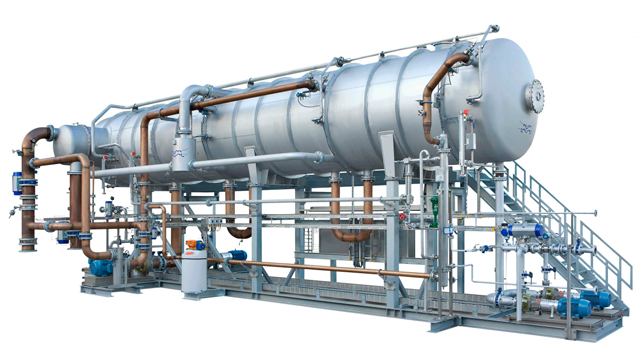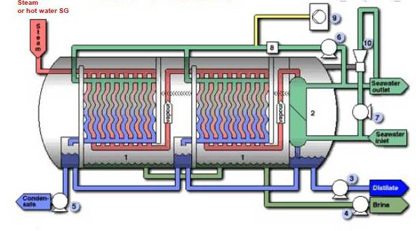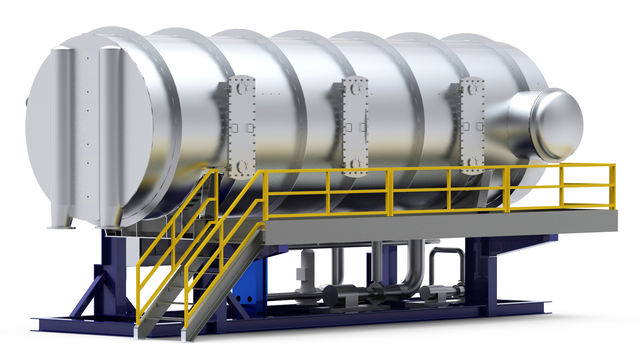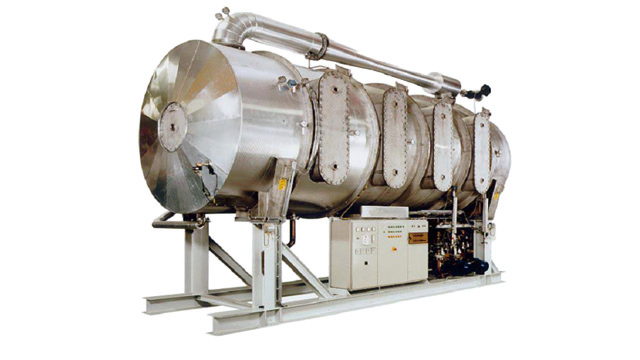Reverse Osmosis Water Treatment for Salt and Sodium Removal RO
MED - Multi-effect desalination
Alfa Laval Multi-Effect Distillation (MED) equipment converts seawater to high purity water for use in power plants, the oil & gas industry, solar desalination, on cruise liners and in industries and domestic water production.

Pioneer within thermal desalination
A multi effect desalination plant is an important component in modern power- and process plants which secures a reliable and cost-effective supply of freshwater by using sea water distillation based on waste heat or low pressure steam.
For modern sea water desalination systems the MED is state of the art in thermal desalination. The distillate from MED plants is high purity water with low dissolved solids content. Further water demineralization downstream of the MED plants is then achieved with significantly reduced chemical consumption and less regeneration of the ion exchange columns.
Custom-designed units
Our product range covers capacities up to 10,000 m3/day per unit. Based on standard components and a modular concept, each unit is custom-designed for each particular installation.
Features
MEP offers high fresh water capacity with small installation footprint and a low weight, a feature particularly valuable in the off shore industry as well as in other marine and land based installations where weight and space can be limiting factors whereas easy installation is of high importance.
How it works
Multi Effect Desalination plants are normally powered by thermal energy, taken as hot water or as low-pressure steam from a boiler or a steam turbine. As the steam has already been used for generating power, the cost of desalination is highly reduced.
The process is based on the evaporation of seawater. This is done by moving the vacuum steam generated by the external energy source over a heating surface to heat the sea water feed on the opposite side of the heat exchanger plates. A part of the seawater flow is evaporated to pure water vapour. The water vapour is then utilized as evaporation energy for the subsequent effect, after which the same process is repeated several times corresponding to the number of effects.

Multe-effect plate distiller
The water vapour generated from the last effect is condensed in the main system condenser cooled by seawater. A dedicated PLC (programmable logic control) system ensures that the desalination unit operates fully automatically with a short start-up period to the required fresh water production.
Special features of MED plants with titanium plates
- Corrosion resistant due to high-grade titanium evaporators
- Compact design with low weight and footprint due to high thermal efficiency of the PHE design
- Controlled thin falling film avoiding dry spots, thereby avoiding scaling
- Short residence time of the media in a PHE unit resulting in faster process response and less scaling
- Easy maintenance - CIP cleaning as well as fully mechanical cleaning is possible
CIP cleaning can remove alkaline soft scaling, and hard scaling can also be removed 100% in a PHE type desalination unit. More than 30,000 installations worldwide
Today, with more than 50 years experience, over 30,000 sucessful installations and references throughout the world, Alfa laval is one of the technology leaders in the desalination field.
GWS has installed a total fresh water capacity of more than 1,000,000 m3/day for offshore platforms, cruise ships, merchant vessels of all types and more than 200 land-based installations for power, industrial and municipal applications.
MEP - Multi-effect plate evaporator
The GWS Multi-Effect Plate (MEP) evaporator is used, among other places, on cruise vessels and at diesel power plants to produce the highest quality fresh water at the lowest possible overall production costs.

Application
Supplying high quality fresh water to meet the demands on board the fleets of the world and at diesel power plants is a challenge that must be addressed in order to support sustainable development. To meet the growing demand for potable and technical water, it is important to be able to provide economical and efficient desalination technologies.
MEP system from GWS
The GWS MEP system is an easy-to-use fresh water distiller that uses seawater to produce the highest quality distillate with conductivity of less than 20 μS/cm at the lowest possible overall production cost.
Economical and highly efficient, the MEP employs combined plate-type evaporator/condenser effects to produce fresh water using the available waste heat from hot water or low-pressure steam, or a combination of both. The self-contained automated MEP evaporator is designed with very high thermal efficiency for high production rates using very little waste heat. Furthermore, the electric energy consumption is kept to a minimum through the use of an optimized pump configuration and the application of frequency controlled motor on the sea water pump.
With its modular design, this highly reliable MEP evaporator is easy to configure to the requirements of any vessel, diesel power plant. Straightforward operation and automated control provides maximum uptime at less cost compared to technologies such as reverse osmosis (RO) and multi-stage flash (MSF). Its lightweight, space-saving design takes up less floor space while offering much higher thermal efficiency in relation to its volume and weight compared to other evaporators.
This enables the production of much higher volumes of fresh water than other desalination technologies. The MEP system offers the lowest possible consumption of both electric energy and chemicals. The electric energy consumption of the four-effect MEP-4-750 desalination unit, for example, is less than 2.5 kWh/m³. Moreover, the MEP does not require brine circulation or any anti-foam injection, and its total anti-scale chemical consumption is less than traditional multi-stage flash units.
How it works
The GWS MEP desalination process consists of a series of evaporation and condensation chambers known as effects (2). Each effect is fitted with heat transfer surfaces based on patented GWS plates. In the plate channels of an effect, seawater on one side is heated up and partially evaporated to distillate vapour, which is used in the next effect; on the other side, the distillate vapour from the previous effect is condensed, giving up its latent heat, into pure distillate.
By maintaining a partial pressure difference across the effects, the process is able to yield maximum efficiency from available low-grade thermal energy sources. The performance and the capitalcost of the system are proportional to the number of effects contained in a unit.

Seawater is pumped into the system via a seawater pump (8) to a condenser (1). Here, the seawater acts as a coolant, removing the heat supplied to the system and thereby maintaining the proper energy balance. In the condenser, the vapour produced in the last effect is condensed into pure distillate.
As distillate vapour is condensed, heat is transferred to the seawater. The seawater pump (8) also transports preheated seawater downstream of the condenser to the various effects (2) of the unit for evaporation. The seawater is led towards the evaporation side of the plate stack, creating a uniform and controlled thin film on the plate. To minimize scaling, the special design of the plate surfaces ensures a uniform flow without any dry areas. On the evaporation side of the plate stack, the seawater is partially evaporated by the heat from the condensation side of the plate stack. The vapour thus produced is passed through a demister to separate salt from the water droplets before the vapour enters the condensation side of the subsequent heat exchanger plates. Here, the vapour condenses into distilled water while transferring its latent heat through the plates to the evaporation side.
The process is repeated in all effects. Finally, distillate and brine are extracted from the last effect. The evaporation takes place at sub-atmospheric conditions, and vacuum conditions are created and maintained by a venting system. The venting system is a water-driven ejector (5 and 6), as shown on the flow diagram.
The venting system removes air from the plant at start-up and extracts non condensable gases during operation of the plant.
GWS MEP in brief
- Low water production cost
- State-of-the-art and user friendly control technology
- Fast start-up and quick response to load changes
- Corrosion-resistant titanium plates
- Patented plate design and thin film process for high thermal efficiency
- Unique construction that allows direct access to heating surfaces
- Evaporator vessel of AISI 316L steel
- High distillate purity and salinity of 5–10 ppm (10–20 μS/cm)
- Capacity range: 180–1000 m3/24 h per unit
TVC - Multi-effect thermo compression desalination
GWS Multi-Effect Distillation units convert seawater to high purity fresh water for use in power plants, the oil & gas industry, solar desalination, on cruise liners and in industries and domestic water production.

Pioneer within thermal desalination
Our Thermo Vapour Compression Distiller is a multi-effect desalination plant with thermo vapour compressor.
A multi-effect desalination plant is an important component in modern power and process plants with secures a reliable and cost-effective supply of freshwater by using sea water distillation based on waste heat or low pressure steam.
For modern sea water desalination systems the MED is state of the art in thermal desalination. The distillate from MED plants is high purity water with low dissolved solids content. Further water demineralization downstream of the MED plants if required is achieved with significantly reduced chemical consumption and less regeneration of the ion exchange columns. The pressure energy of the steam can be used more efficiently with Thermo Vapour Compression (TVC-MED)
Our product range covers capacities up to 10,000 m3/day per unit. Based on standard components and a modular concept each unit is custom designed for each particular installation.
Features and benefits
- Titanium plate type evaporators
- Full access to evaporator heat transfer surfaces
- Lowest total water production costs
- Highest availability
- Fully automatic operation and low maintenance costs
- High distillate purity
- Enhanced performance by means of thermos vapour compression
